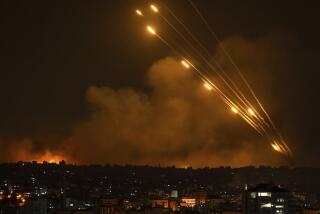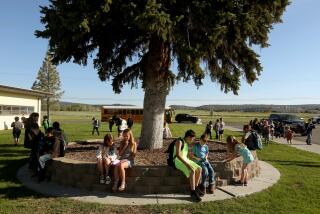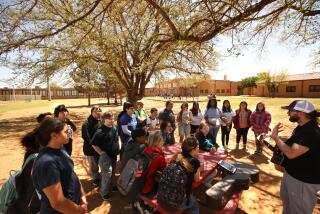A Schooling in Both Religion and Doubt
- Share via
I suppose I am something of an expert on prayer in school. I went to Catholic schools.
From my first day at Saint Salome’s grammar school, through Our Lady of Mercy High School and until I received my B.A. degree--handed to me by Francis Cardinal Spellman--from the College of New Rochelle, I had never spent a school day without prayer in the classroom. Sixteen years.
My first prayer-less school day was at New York University where I showed up to get a Master’s in English in the fall of 1962. A Godless place, I had been warned. All I know for sure is, no professors at NYU started their classes with prayers.
At Saint Salome’s, named for Mary of Salome who stood at the foot of the cross, the day always started with us standing in the aisles beside our desks, reciting the Morning Offering and a few other prayers that the teacher, always a nun in those days, favored. And we did it again in the afternoon.
What I remember most distinctly was the year, maybe fourth grade, when we started the afternoon by praying to St. Joseph for the grace of a happy death. Because tradition had it that Joseph had died with Jesus and Mary at his side, and therefore happily, he was the patron saint of a happy death, and we asked him to intercede for us in heaven. Even then I remember thinking there was something unusual, maybe odd to some, about a bunch of children praying about their deaths.
These were not always reverent or inspirational occasions. If I remember my catechism correctly, prayer is the lifting of the mind and heart to God. Some did that, some didn’t. But it was the height of daring to poke the kid in front of you or make faces. This was on a different plane than talking in class.
There were special occasions, prompting more prayers. The most awesome were perhaps the H-bomb drills of the early ‘50s. All students would file quickly and silently into the hallway and sit on the hardwood floors in rows. We would hug our knees, rest our heads on them, and while we sat that way, one of the nuns, usually Sister Borgia, would walk back and forth among us, leading us in the Rosary, our muffled voices following her as we prayed for world peace.
Prayer intensified in high school and college. We switched classes every hour or less, and we started each class with a prayer. In French class, it was Je vous salue, Marie and Notre Pere, qui est aux cieux. “Hail, Mary.” “Our Father, who art in heaven.” In college, the lay professors were either perfunctory and sloppy, rushing through fragments of ritual, or a little stagey, dragging out a formula.
Of my college teachers, Mother Grace was the best regarding prayer. She taught a course in Dante and would kneel right down on the floor, leading us devoutly. Then she’d rise, only to descend with us deep into the nine circles of the inferno, relishing especially Dante’s Florentine politics as we would learn whom he’d damned that day.
All of this praying was part of an entire culture. The secular and sacred were intertwined in this world, and dogma, values, ethics and traditions were not confined to religion or theology classes.
These kinds of memories invariably affect me and my friends who share them with nostalgia, anger, bitterness, amusement--the whole Catholic school bag.
It’s against such a background that I recall the actual prayers in the classroom.
This may be why I’ve always had a hard time relating to the constitutional issue of prayer in the public schools. I often think that many prayer proponents aren’t really talking about the lifting of minds and hearts to God. They seem more involved with the politics of religion, and prayer in such a context takes on the aspect of an in-your-face swipe at the opposition.
The more sincere, I think, are looking for that total immersion I experienced. The prayers were the least of it, and if you’re to get it at all, my guess is you get it in a denominational school.
I think the world I grew up in had as much in common with the Middle Ages as it did the 20th Century, and I doubt that very many Americans, including Catholics, live that way today.
Vatican II changed more than the Latin Mass. All was thrown into question; the absolutes are not so absolutely given; there are no longer enough nuns to staff the schools. And if some of the same rituals and mores and catechism are taught, the children go out into a different world when the bell rings.
What was the result of that education? I can no longer say I believe the dogma--although I have a hard time saying I don’t. I do not practice the religion and reject outright some of its moral canons. I’m not sure what I believe at all.
And yet, it took. There is no denying that my values, my world view, my whole moral frame of reference and the existential questions that concern me derive from that experience--even when it leads me to reject it. It’s more than a part of me; it’s me.
It was not those interludes of formal prayer at school that did it. The prayers were perfunctory greetings, reminders that sometimes did remind. For me, and I’d guess this was so for many if not most, my mind would wander during prayers; I’d be distracted, aware I felt guilty that I was distracted, or, as with praying for a happy death, not so much involved in the prayer as objectively aware of it.
It was in the whole of that world where I lived--in school, in church, at home and in those moments when I prayed alone--that the experience made its indelible mark.
And what is the aim of those who would have children pray in public schools now? What are they looking for? Whatever it is, I don’t think they would find it with such a simplistic remedy as a moment of prayer.






